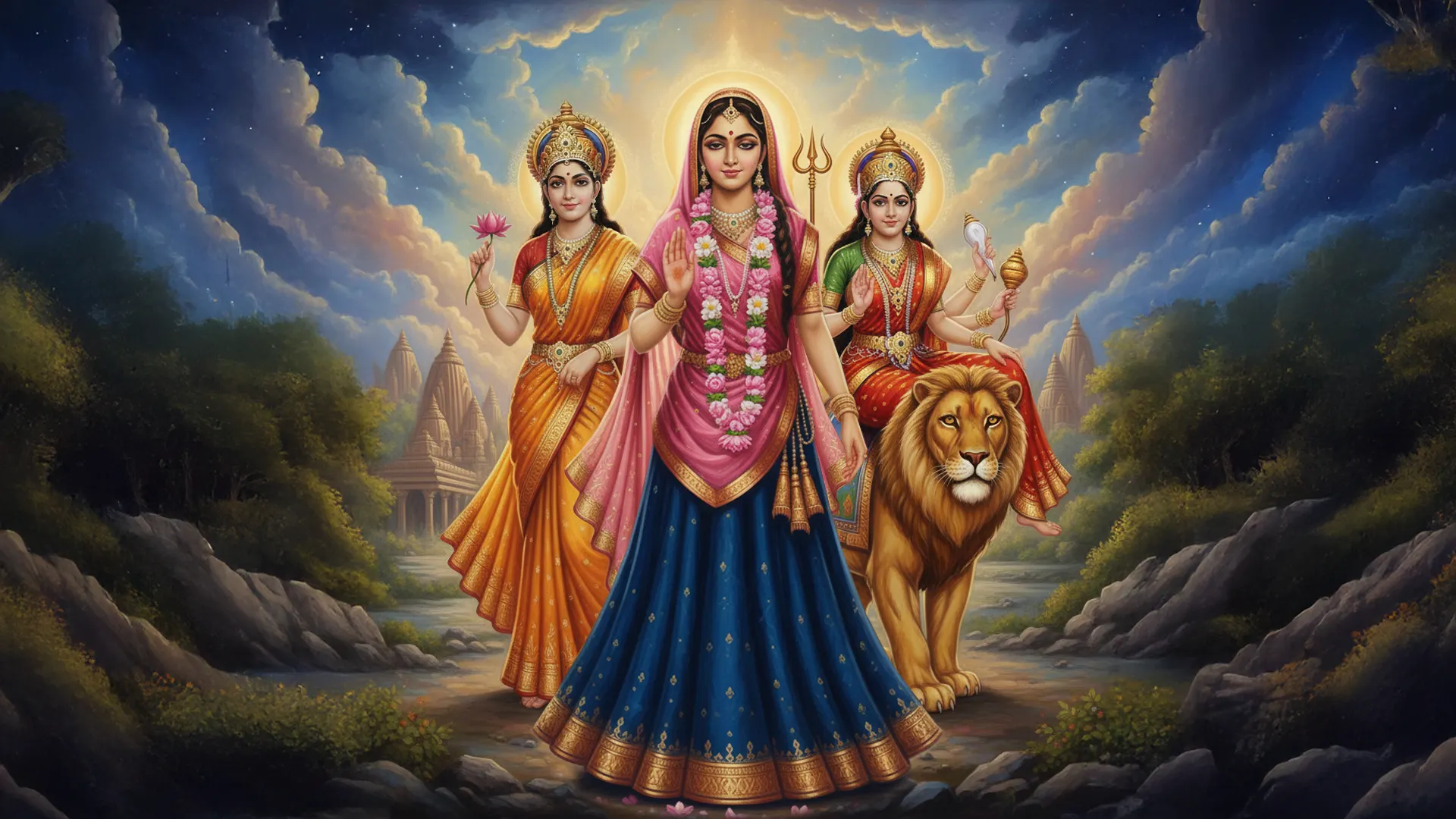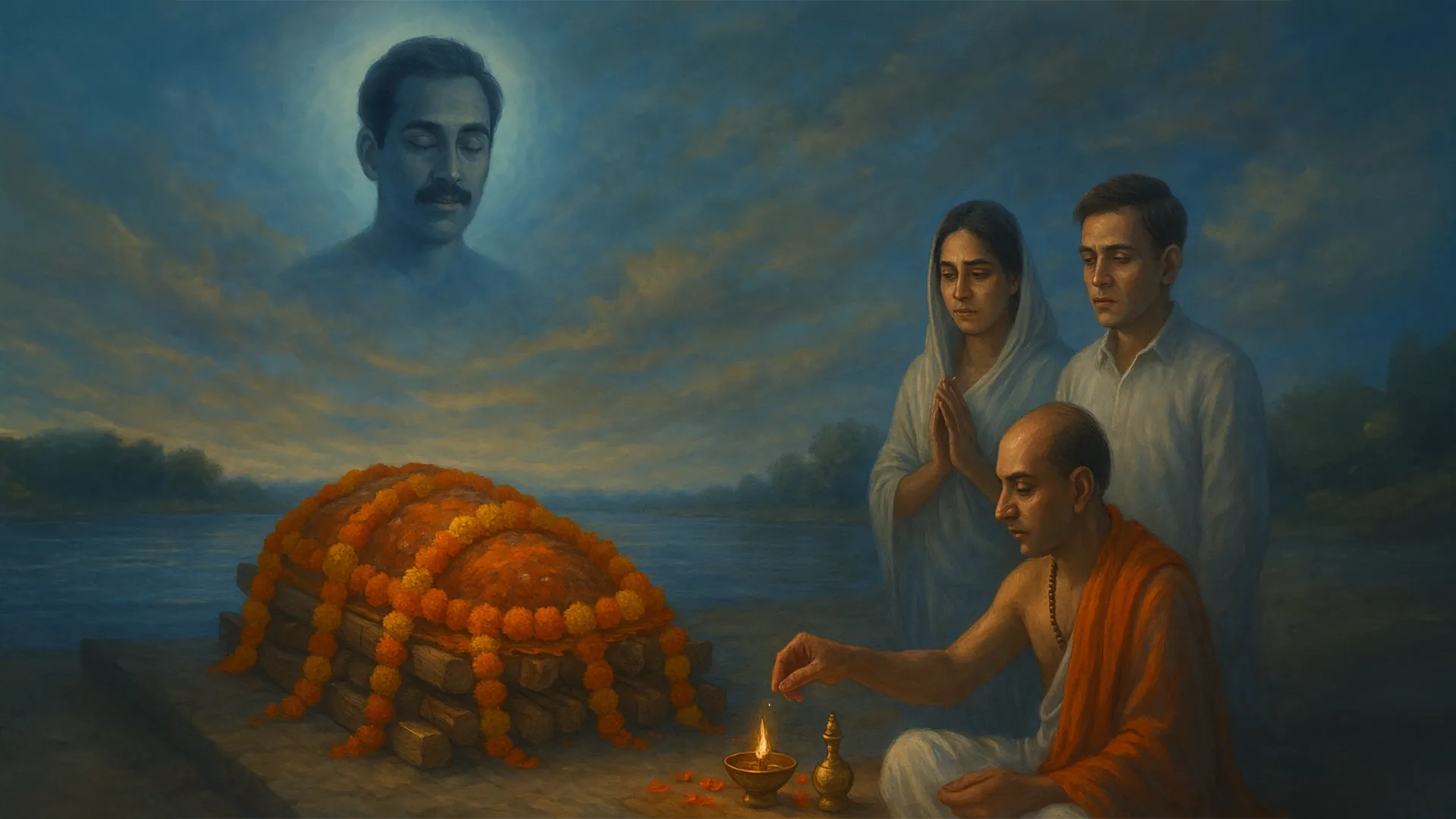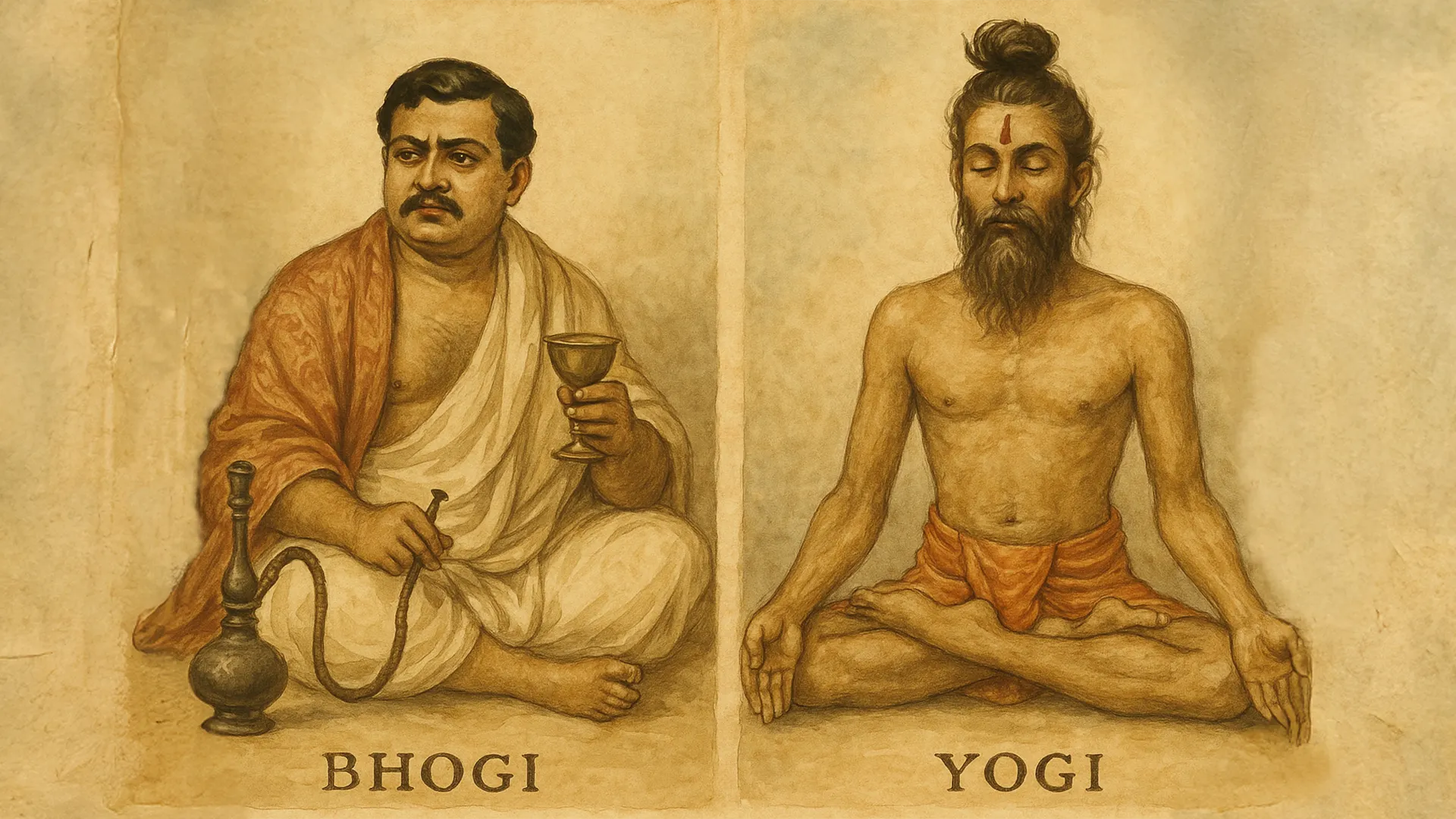Who am I? What do I need? How to be happy? What's right, what's wrong—and how do I even decide?
Some questions never get old. No matter how far we advance in science or technology, these timeless puzzles keep returning. You may be building a career, exploring relationships, or just figuring out life, but deep down, the mind often circles back: What is the bigger picture?
To answer these questions, the world has come up with countless schools of thought. In the West, there are ideologies like Nihilism, Existentialism, Rationalism, Idealism, Modernism, Postmodernism, etc. In India, we have profound philosophies like Advaita, Dwaita, Vishishtadvaita, etc. But amidst all this, one confusion often lingers: "What path leads to true understanding of life and lasting bliss?"
In this article, we turn to the Vedic Sanatan tradition—a timeless philosophy that doesn't ask you to escape or blindly follow the world. Instead, it shows how spiritual growth and material life can most effectively complement each other. It’s not just about belief—it’s about a complete, practical framework that speaks to the soul and the intellect.
This world, beautifully crafted by the Divine, is full of contrasting hues. And we? We’re like pendulums—swinging between spiritual yearning and material ambition. One moment, we are meditating on peace; the next, we are chasing goals. One side says to renounce the world. The other says to indulge in it fully. So what’s the answer? Must we choose one over the other?
Let’s explore this dilemma through the lens of Swami Mukundananda’s discourses, where ancient wisdom meets contemporary life and where you might just find the answers you’ve always carried within.
When Desire Rules: The Materialist Philosophy of Charvak
One of the strongest voices representing the materialistic school of thought in Eastern philosophy is Charvak, known for denying the soul, rebirth, or any higher spiritual purpose. He is regarded as a disciple of Brihaspati, the guru of the gods, who, according to the Padma Purana, propounded this atheistic, anti-Vedic view with a deliberate purpose: to mislead the asuras (demons). When the asuras became too powerful by adopting the path of austerity, the Vishnu Puran recounts how the devas pleaded to Bhagwan Vishnu. In response, He manifested a being called Māyāmoha, who appeared on the banks of the Narmada River and preached this deceptive, materialistic philosophy to delude the asuras and turn them away from the righteous path.
Sage Javali in Valmiki Ramayan echoes similar logic when trying to convince Bhagwan Ram to return to Ayodhya—dismissing dharma and the afterlife. Even the name Charvak, from charu (sweet) and vaak (speech), suggests the appeal of this worldview: seductive logic promising pleasure through indulgence.
This famous verse by Charvak captures the core belief of materialist thought:
यावत् जीवेत् सुखम् जीवेत्। ऋणं कृत्वा घृतं पिबेत्।
भस्मीभूतस्य देहस्य पुनरागमनं कुतः।
Yavat jeevet sukham jeevet, rinam kritva ghritam pibet
Bhasmi-bhootasya dehasya punara-gamanam kutah
As long as you live, live happily. Take debt and drink ghee. Once the body is reduced to ashes, how can it come back?
While intellectually appealing, Charvak’s view stands in stark contrast to the teachings of realised saints and Vedic scriptures and many people today live by this principle, pursuing pleasure without concern for long-term consequences.
Seeing Beyond the Body: A Spiritual Perspective from Vedas
Having understood the materialistic view, let’s now turn to the spiritual lens. The Vedic scriptures clearly distinguish the body from the soul—and this shift in understanding transforms the entire meaning of life.
The Bhagavat Gita (2.13) says:
देहिनोऽस्मिन्यथा देहे कौमारं यौवनं जरा |
तथा देहान्तरप्राप्तिर्धीरस्तत्र न मुह्यति ||
Dehino-asmin-yatha dehe kaumaram yauvanam jara
Tatha dehantara-praptir-dhiras-tatra na muhyati
Meaning: Just as the embodied soul continuously passes from childhood to youth to old age, similarly, at the time of death, the soul passes into another body. The wise are not deluded by this.
Shreemad Bhagavatam (3.31.31-44) says-
जीवो ह्यस्यानुगो देहो भूतेन्द्रियमनोमय: ।
तन्निरोधोऽस्य मरणमाविर्भावस्तु सम्भव: ॥ ४४ ॥
Jeevo hyasyaanugo deho bhoota indriya manomayaha,
Tannirodho'sya maranam aavirbhavastu sambhavaha.
Meaning: The living being (soul) is indeed accompanied by a body composed of the elements, senses, and mind. The cessation (of the body) is called death, while the manifestation (of the body) is referred to as birth.
The above verses from the Gita and the Bhagavatam—and countless others across the Vedas, Upanishads, and Puranas—affirm that the foundation of Eastern spirituality lies in the truth that the soul is eternal and the body merely its temporary garment. Just as you discard worn-out clothes, the soul sheds old bodies and takes on new ones across countless lifetimes. In this view, death is not a full stop—it’s merely a comma in the long, ongoing sentence of existence. Birth and death are transitional moments, not absolute beginnings or ends. This viewpoint entirely shifts your orientation—from chasing fleeting pleasure to seeking eternal fulfilment and peace.
Why We Long for Bliss: The Real Question
Now that we’ve explored the core principles of both materialism and spirituality, the real challenge lies not just in understanding who we are, but in learning how to live amidst conflicting desires and demands. These two opposing views—materialism on one side and spirituality on the other—often leave us torn, uncertain, and searching for clarity.
Yet despite all the diversity of thought and disagreement, one truth remains undeniable: every soul, regardless of its chosen path, ultimately seeks bliss. Whether an action is right or wrong, noble or selfish, it stems from this deep, inherent longing for happiness.
But this raises a deeper question: Why do we seek bliss in the first place?
Swami Mukundananda illuminates this through the timeless wisdom of the Vedas. He explains that the first step is to understand what true bliss is—and where its real source lies. According to the Vedas, Brahman—Bhagwan, the Supreme Divine—is Sat-Chit-Anand: eternal existence, pure consciousness, and infinite bliss.
As the Taittiriya Upanishad states:
आनन्दो ब्रह्मेति व्यजानात्।
आनन्दाध्येव खल्विमानि भूतानि जायन्ते।
आनन्देन जातानि जीवन्ति।
आनन्दं प्रयन्त्यभिसंविशन्तीति।
Anando brahmeti vyajanat
Ananda-dhy-eva khalvi-mani bhootani jayante
Anandena jatani jeevanti
Anandam prayanty-abhi-samvishanti
Meaning: Brahman is the embodiment of bliss itself. All beings are born of bliss, live by bliss, and ultimately return to bliss.
So, if Brahman is pure bliss, what about us—the individual souls?
Shree Krishna clarifies in the Bhagavad Gita (15.7):
ममैवांशो जीवलोके जीवभूत: सनातन: |
Mamaiva-amsho jeevaloke jeevabhootah sanatanah
Meaning: The embodied souls in this material world are My eternal fragmental parts.
Being fragments of the all-blissful Brahman, the soul naturally seeks bliss. But the bliss the soul longs for is not the fleeting pleasure of the material world—it is the eternal, divine bliss of its source: Brahman.
Why then do we chase material pleasures?
Because the soul resides in a body (including mind, intellect and senses) made of maya—prakriti, the primordial nature or the material energy of God. The senses and mind, tied to this body, are naturally pulled toward its source- the material world and its pleasures. As Shree Krishna continues in the same verse:
मन:षष्ठानीन्द्रियाणि प्रकृतिस्थानि कर्षति ||
Manah shashthani indriyani prakriti-sthani karshati
Meaning: But bound by material nature, they are struggling with the six senses including the mind.
Which Bliss Do We Seek? The Material or the Spiritual?
Here lies the real confusion—the body and the soul come from different sources, so their impulses toward bliss diverge. The body, born of maya, craves momentary sensory pleasure. But the soul, being a part of the eternal Sat-Chit-Anand Bhagwan, yearns for everlasting, divine bliss.
So, the critical question we must ask ourselves is:
Which bliss are we truly seeking?
The temporary thrill of sense gratification—or the soul-deep fulfilment of divine connection?
Which bliss are we truly seeking?
The temporary thrill of sense gratification—or the soul-deep fulfilment of divine connection?
Instinctively, we all seek the latter. But then comes the next dilemma:
How do we attain it? Does it mean we must renounce worldly life completely?
Absolutely not. The key lies in balance—harmonising our material responsibilities (dharma) with inner spiritual growth. This body, though temporary and limited, is still a sacred gift from God—a tool for realising the eternal.
As the scriptures affirm:
"शरीरमाद्यं खलु धर्मसाधनम्"
Sharir madhyam khalu dharma sadhanam
Meaning: The body is indeed the first instrument for practising Dharma.
Videhraj Nimi in Shreemad Bhagavatam (11.2.29) declairs:
"दुर्लभो मानुषो देहो देहिनां क्षणभङ्गुरः।
तत्रापि दुर्लभं मन्ये वैकुण्ठप्रियदर्शनम्॥
Durlabho manusho deho dehinaam kshana-bhangurah
Tatraapi durlabham manye Vaikuntha-priya darshanam
Meaning: This human birth is extremely rare and fragile, even more rare is the chance to have darshan of Bhagwan's devotees and tread the path of devotion.
Prahlad tells his asura friends (Bhagavat 7.2.6):
यथा हि पुरुषस्येह विष्णोः पादोपसर्पणम्।
यदेष सर्वभूतानां प्रिय आत्मेश्वरः सुहृत्॥
Yatha hi purushasyeha Vishnoh paadopa-sarpanam
Yadesha sarvabhootaanaam priya atmeshwarah suhrit
Meaning: There is no greater blessing for a human being than to approach the lotus feet of Bhagwan Vishnu, who is the beloved, the true Self, the Master, and the dearest friend of all living beings.
Synthesising Material Health and Spiritual Growth
So, to maintain this body—the vehicle of the soul—it is essential to nourish it with the right balance of carbohydrates, proteins, fats, vitamins, minerals, and fibres. But that alone is not sufficient. The body also requires the timeless wisdom of Yog, Pranayam, and Ayurveda—ancient sciences gifted by the sages—to function at its highest potential.
A healthy body is not merely about physical comfort; it serves as a vital instrument through which the soul expresses itself and advances on the path of realisation. However, when material knowledge is used solely to indulge selfish desires, it binds the soul deeper into Maya. This results in restlessness, anxiety, and ultimately, spiritual decline.
A story that beautifully illustrates this balance comes from the life of Gautam Buddh. Before attaining enlightenment, He practises extreme austerities—abstaining from all food and water while meditating, hoping to enter Samadhi. Days pass, but instead of experiencing higher realisation, He only grows weaker. Confused, He wonders why His sincere efforts bear no fruit.
Just then, a group of village women pass by, singing a folk tune that strikes Him deeply: "Tanpura ki taan kaso thik-thik se, par itna bhi na kaso ki toot hi jaye jhatse." (“Tune the strings of the tanpura with care—not so tight that they break.”)
In that simple line, He grasps profound wisdom. Controlling the mind, senses, and intellect is essential. But when the body—the very medium for spiritual practice and service to God—is neglected or pushed beyond its capacity, it becomes counterproductive. Without the body, even the highest spiritual endeavours come to a halt. Balance is not just ideal—it is essential.
This realisation is just as vital today. Material actions, when offered with spiritual intent, become acts of worship. But when performed without devotion, even noble deeds turn dry and mechanical.
As Einstein once admitted after witnessing the destructive power of the atomic bomb—based on his own formula E = mc²:
"Science has succeeded in denaturing the Plutonium atom, but it cannot denature the evil in man’s heart."
This highlights a sobering truth: no amount of material advancement can uplift the soul unless it is infused with spiritual wisdom. Only through mastering the art of Yog—balancing worldly responsibilities with inner growth—can one move swiftly toward the ultimate goal.
In fact, when seen through the lens of higher knowledge, the conflict between the material and spiritual dissolves—for everything, in essence, has emerged from the same divine source.
The Taittiriya Upanishad declares:
यतो वा इमानि भूतानि जायन्ते, येन जातानि जीवन्ति,
यत् प्रयान्ति अभिसंविसन्ति, तद् विजिज्ञासस्व, तद् ब्रह्म।
Yato va imaani bhootaani jaayante, yena jaataani jeevanti,
Yat prayanti abhisam-visanti, tad vijigna-asasva, tad brahma
Meaning: That from which all beings are born, by which they live, and into which they merge after death—know That to be Brahman.
Shree Krishna in Gita (10.8) says:
अहं सर्वस्य प्रभवो मत्त: सर्वं प्रवर्तते |
इति मत्वा भजन्ते मां बुधा भावसमन्विता: ||
Aham sarvasya prabhavo mattaḥ sarvam pravartate
Iti matva bhajante maam budhaa bhaava-samanvitaah
Meaning: I am the origin of all creation. Everything proceeds from Me. The wise who know this perfectly worship Me with great faith and devotion.
This universe is not separate from God. Every atom pulsates with His presence. Even the material energy (maya) is His. दैवी ह्येषा गुणमयी मम माया दुरत्यया daivi hyesha gunamayi mama maya duratyaya. Shree Krishna says (Gita 7.14)-“My divine energy Maya, consisting of the three modes of nature, is very difficult to overcome.” Thus, when we perceive the world with devotion, we realise: there’s no real divide between materialism and spiritualism. The apparent differences arise only from our limited understanding. When we stop identifying with the body and realise ourselves as the soul, all confusion and division dissolve, and with minds fixed on the Divine, true bliss and contentment naturally arise.
As Shree Krishna in next verse of Gita (10.9) declare:
मच्चित्ता मद्गतप्राणा बोधयन्त: परस्परम् |
कथयन्तश्च मां नित्यं तुष्यन्ति च रमन्ति च ||
mach-chitta mad-gata-praana bodhayantah parasparam
kathayantash cha maam nityam tushyanti cha ramanti cha
Meaning: With their minds fixed on Me and their lives surrendered to Me, My devotees remain ever content in Me. They derive great satisfaction and bliss in enlightening one another about Me and in conversing about My glories.
In the above verse Shree Krishna is refering to such yogis or devotees who have truly realised that their real identity is the soul (atman), not the physical body. Their consciousness remains centred on this eternal self, and with their minds fixed on Him, they live in complete surrender—experiencing deep, lasting bliss and inner contentment.
Karma Yog: Bridging Materialism and Spiritualism Through Selfless Action
The way to reach this state of soul-consciousness is through Karma Yog. In today’s world, this practical path means performing your duties with dedication, detachment, and surrender to Bhagwan. Such action purifies the mind and gradually helps you rise above bodily identification, even while fully engaged in the world.
Every God-gifted talent—when offered in His service—becomes worship.
Every small action—when performed in remembrance of Him—becomes a means to stay spiritually elevated, even amidst the chaos of modern life.
Every small action—when performed in remembrance of Him—becomes a means to stay spiritually elevated, even amidst the chaos of modern life.
As Swami Vivekananda rightly said:
"No work is secular, all work is devotional."
Sant Kabir Das Ji echoes this sentiment:
जहाँ जहाँ चलूं करूं परिक्रमा, जो जो करूं सब सेवा,
जब सोवूं करूं दण्डवत्, जानूं देव न दूजा।
Jahan jahan chaloon karoon parikrama, jo jo karoon sab seva,
Jab sovoon karoon dandavat, jaanoon dev na dooja.
Meaning: Wherever I walk, I consider it circumambulation; whatever I do, I consider it seva; even when I sleep, I feel I am bowing to God—there’s no deity other than Him.
Materialism and spiritualism are not adversaries—they are allies, when rightly balanced. As Shree Kripalu Ji Maharaj said in Bhakti Shatak (84):
मन हरि में तन जगत में, कर्मयोग तेहि जान।
तन हरि में मन जगत में, यह महान अज्ञान॥
Mana Hari Mein Tana Jagat Mein, Karmyog Tehi Jaan.
Tana Hari Mein Mana Jagat Mein, Yah Maha Agyan.
True karma yog is when your mind is absorbed in Shree Krishna’s love and you are performing your duties with your body. If your mind is attached in the world, and physically you are doing devotional formalities, then you are extremely ignorant (because it is only karma, not karma yog).
True wisdom lies in recognising that materialism and spiritualism are not separate roads but two sides of the same coin—each incomplete without the other. When you embrace this unity and live with awareness that the body is the house and the soul its eternal occupant, every experience gains profound meaning. The highest state is reached not by renouncing the world, but by engaging with it wisely, while remaining rooted in spiritual consciousness. In this balance, your actions become a sacred offering, your challenges a path to growth, and your life a radiant reflection of the divine harmony that underpins all existence.








